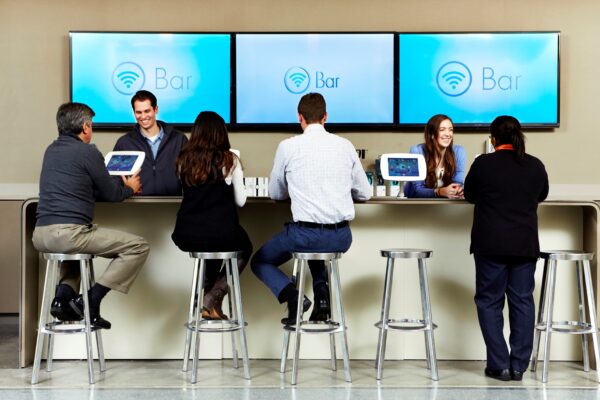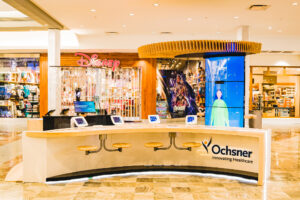
Ochsner’s O Bar
While health systems aren’t considered meccas of innovation, more and more hospitals are launching efforts aimed at transforming healthcare. Visits to Mercy Health, Henry Ford and OSF HealthCare showed how Midwestern health systems are taking on innovation. But what about a health system in the South? A recent visit to Ochsner Health System in Louisiana sheds some light on how the organization is bringing an inventive approach to consumerism, chronic disease and the hospital itself.
A little more than four years ago, the health system launched innovationOchsner, its innovation lab. iO encompasses various parts of Ochsner’s work, one of which is the O Bar.
To put it simply, the O Bar is a long bar filled with several iPads on stands. A technology specialist is behind the counter, ready to answer questions. Think of it as similar to the Apple Genius Bar; in fact, iO CEO Aimee Quirk said Ochsner took a cue from Apple’s famous tech support station. In addition to a mobile O Bar, there are currently seven O Bar locations at Ochsner facilities and an Ochsner fitness center.
The O Bar has multiple goals, one of which is patient education. Using the available iPads and with help from the tech specialist, individuals can learn more about how to use the Epic MyChart (or MyOchsner) patient portal app. The iPads are also fitted with more than 300 doctor-approved health apps, which users can try out. Another aim of the O Bar is to serve as a semi-retail environment where patients can purchase health devices like Fitbits. People use the O Bar most for getting app recommendations and support, followed by signing up and getting support for MyOchsner.
A third aspect of the O Bar ties into Ochsner’s digital medicine programs. These efforts primarily tackle chronic diseases like hypertension and diabetes, though there is a program for pregnancy as well. Ochsner is also piloting a program for COPD, and it is in its infancy stages.
Here’s a closer look at how one of the programs — hypertension — works: A doctor can enroll hypertensive patients in the program. The only requirement is that they have a smartphone. Patients can then pick up a wireless blood pressure cuff either at the O Bar or via mail fulfillment. They’re instructed to regularly take their blood pressure, and readings are automatically integrated with the EHR. Thus, patients’ care teams are able to monitor data over time and intervene when necessary.

A Deep-dive Into Specialty Pharma
A specialty drug is a class of prescription medications used to treat complex, chronic or rare medical conditions. Although this classification was originally intended to define the treatment of rare, also termed “orphan” diseases, affecting fewer than 200,000 people in the US, more recently, specialty drugs have emerged as the cornerstone of treatment for chronic and complex diseases such as cancer, autoimmune conditions, diabetes, hepatitis C, and HIV/AIDS.
“The ultimate aim is to improve the health of as many people as possible in a sustainable and viable way,” said Dr. Pedro Cazabon, Ochsner’s system department chair of primary care. He added that a benefit of the program is giving patients more connectivity to their team.
The health system has seen clinical outcomes, too. In a study published in The American Journal of Medicine, Ochsner found that at 90 days, 71 percent of patients in the hypertension digital medicine cohort achieved target blood pressure control, compared to 31 percent of patients receiving usual hypertension care.
Ochsner’s program for diabetes works in the same manner, with patients receiving a digital glucometer to conduct blood sugar readings at home. Similarly, its initiative for pregnancy, called Connected MOM, allows pregnant women to track their weight, blood pressure and urine protein test results and digitally send them to their care team.

The InnovationHub at Lakeside Shopping Center / Photo: Ochsner
In addition to the digital medicine programs, Ochsner has another way of connecting with patients outside the four walls of the hospital. It recently opened its first InnovationHub at Lakeside Shopping Center in Metairie, Louisiana. The purpose of the hub, which is staffed with “ambassadors” who can answer questions, is to spark mall-goers’ interest in health and wellness. Its features include stations for sanitizing cellphones with UV light, an iPad bar (like the ones at the O Bars), interactive quizzes and more. Looking forward, Ochsner plans to add more InnovationHubs in locations throughout the state. It will be interesting to see if this effort is permanent. Mayo Clinic launched its retail health and wellness location in the Mall of America in Minnesota in 2011 only to close it two years later. Mayo has brought its effort in health and well-being in-house — in its main Rochester, Minnesota campus.
The Louisiana health system is applying innovation inside the hospital as well. In an effort to prevent patient deterioration, Ochsner has implemented artificial intelligence in some of its facilities. The technology relies on Epic’s machine learning platform as well as cloud computing service Microsoft Azure. If something goes wrong, the tool can alert Ochsner’s rapid response team, which can proactively intervene rather than catching a negative change too late. During a 90-day pilot of the AI, Ochsner decreased adverse events outside the ICU by 44 percent.
Another effort involves what Ochsner calls the Optimal Hospital. It is a “recognition that there are opportunities for improvement in terms of routine,” said Dr. Richard Milani, Ochsner’s chief clinical transformation officer.
Rooms in the Optimal Hospital program observe nightly quiet hours so there are fewer noise disturbances that can wake up patients, and routine lab draws are delayed until after 6 AM so patients have more time to sleep. If nurses need to check on patients after hours, they use red night lighting, which is less disruptive to circadian rhythms than white or blue light.
Patients get tablets, which they can use to view their health data and watch select entertainment content. Vitals are taken using wireless wearable devices, and clinicians can receive vitals alarms and alerts from tablets and smartphones. In a bid to reduce infections, rooms contain sheets, towels and surfaces infused with copper, which has antimicrobial properties.
According to a study published in The American Journal of Medicine, Ochsner found that a combination of some of the Optimal Hospital features — such as quiet hours, red lighting, delaying routine phlebotomy until after 6 AM, wireless vitals monitoring, nurses getting vitals alerts via iPhones and patient access to health data via an iPad — helped reduce length of stay by 8.6 hours, lower 30-day readmission rates by 16 percent and lower 90-day readmission rates by 12 percent.
Ochsner’s innovation initiatives span clinical and non-clinical areas in and out of the health system. Whether improving the inpatient experience or leveraging technology to help individuals better manage their conditions, the system strives to improve the experience and health of patients and consumers.
Photo: Ochsner













